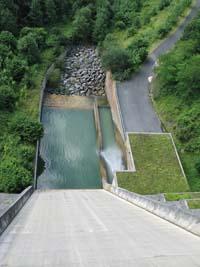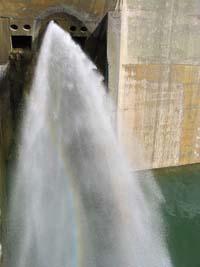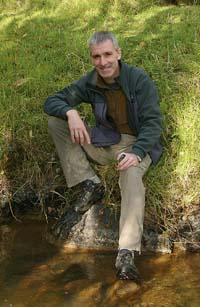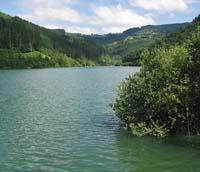Essential water, even in rivers

However, as we have developed societies, we have needed more and more water and, of course, we have been drinking more water from rivers. Many times we have not taken into account that rivers are something to be looked after and we have considered them as a simple source of water. That is, that desire to satisfy our needs has made us forget the needs of rivers.
In recent years this approach is changing. The EU authorities, for example, have become aware of the problem and have adopted an ambitious commitment: Conserve, protect and improve the environment of all Union countries. Regarding aquatic ecosystems, the Water Directive was published in 2000, establishing as a challenge that by 2015 all the water masses are in good ecological condition. This law launched all member states.
To maintain a good ecological condition, the first thing a river needs is to have enough water. To know if a quantity of water is sufficient, you have to look at the functioning of this river. The minimum amount of water needed by the river is necessary to develop living things that would live in their natural state. This minimum flow rate is called ecological flow. Once this demand for the river is respected, we could take advantage of the remaining water for our needs, without disturbing the river.
No ecological flow footprint

This perspective is not included in any of the current laws. Moreover, until recently the conservation of the rivers was not among the objectives of those who made rules to manage the use of water. As an example, the Hydrological Plan of the North III basin in force in the Autonomous Community of the Basque Country in 1998, points out in relation to the state of ecological flows:
"In the areas where water is currently being exploited, although they have the possibility of regulation, they do not have defined, except for a few cases, any flow that is intended to protect the environment. The few who respect such a flow or need to be respected do so because they have to dilute the spills." He adds that the implementation of ecological flows in reservoirs is also a "significant loss of resources that could serve other uses".
Of course, if no one ordered, those who received water from the rivers would not begin to 'waste' their resource. In water use concessions - authorizations for use under certain conditions - nothing was said about it, so the trend was widespread that reservoirs and catchment points would not leave a drop of water to the river or natural stream.
Ecological flow in concessions
This hydrological plan, once the scenario is described, describes the action plans. Among other things, they say that rivers must be respected and that to fulfill their functions they need a minimum amount of water, that is, leave an ecological flow in the areas where water is exploited.

As for the concessions already approved, the hydrological plan says nothing. Until the time of renewing these concessions, they will not have to take such measures. Thus, according to Arturo Elosegi, expert in river ecology and professor of ecology of the UPV, "in many places you can see that under the dam nothing is left".
Another problem can be in locations with new concessions, that is, if those who have to leave the water to the river meet or do not have to do it. There are many places to control and inspectors or technicians do not reach the necessary follow-up.
However, Elosegi believes that this problem can be easily solved: "The reservoir gates open and close with a key that is currently owned by reservoirs. They commit to leaving a flow below the dam and a technician must check if they comply with the indicated. It would be easier for inspectors to have the keys to the reservoirs and to be able to open and close the gates."
Enough?

Although current legislation is respected, it would probably not be enough to meet the challenge posed by the European Water Directive. Now a single flow has been defined, that is, except for exceptions, in places that exploit the water throughout the year let out the same amount of water. They consider that river communities need a certain amount of water to survive and that it is enough to respect that minimum amount.
And it is true, communities can survive with a minimum amount of water, to which they are adapted because, in natural circumstances, sometimes, there are times of little water. What happens is that these times do not last long in nature, after a landing always rise rainfall. Therefore, despite suffering landings, they are not indefinitely adapted to live on land.
Depending on the time of year, river communities need a certain amount of water. Some living beings, for example, need flooding to complete their biological cycle. Therefore, it is very important that the flow rises and falls, so it would be necessary to take into account these incidents when the flow of a river is in our hands.
New hydrological plan underway
In compliance with the provisions of the European Water Directive, that is, with the aim of improving the ecological status of all rivers, in the Autonomous Community of the Basque Country a new Hydrological Plan is being developed in the Basque Water Agency how to manage water from it. They have not yet finished --they are editable next year -, but they have made a scheme with the topics to consider. Iñaki Arrate, hydrological planning technician of the Basque Water Agency, informed us about this scheme.

However, they describe the premises that the ecological flow must meet. Among other things, they say that they have to calculate ecological flows taking into account biological variables, which cannot be fixed and that each section must have its ecological flow.
These premises propose a modular ecological flow method to determine ecological flows in the Autonomous Community of the Basque Country. This method proposes dividing the year into three sections and defining for each of them a minimum ecological flow for the months of July, August, September and October; means for the months of May, June, November and December; and the maximum for the months of January, February, March and April.
For the calculation of these flows, data on the daily flow of each section in unregulated areas have been taken into account. The ecological flow corresponding to this section would be 10% of the average flow of the section in each group of months.
As can be seen, at least for the calculation the first mentioned premise has not been taken into account, that is, they have not been based on biological variables. However, the scheme of the new hydrological plan indicates that it represents very well the ecological flows that would be obtained calculated by biological methods.

In Elosegi's opinion, this is a too general method, which understands that "we should look for more than one formula and that each stream should have its objectives, since each has its characteristics and needs. Therefore, it is very likely that some will need more water than others" to ensure a good ecological state.
What nobody doubts is the modular ecological flow that proposes that the 10% fixed they leave now is better than that 10%. In addition to proposing, Arrate himself told us that the modular ecological flow has already begun to be used in the rivers that begin and end their journey in the community.
Therefore, we can say that the state of our rivers is improving. However, we will still have to wait a little while for all the measures they take to start and become widespread… and so that we can see life in our rivers.






